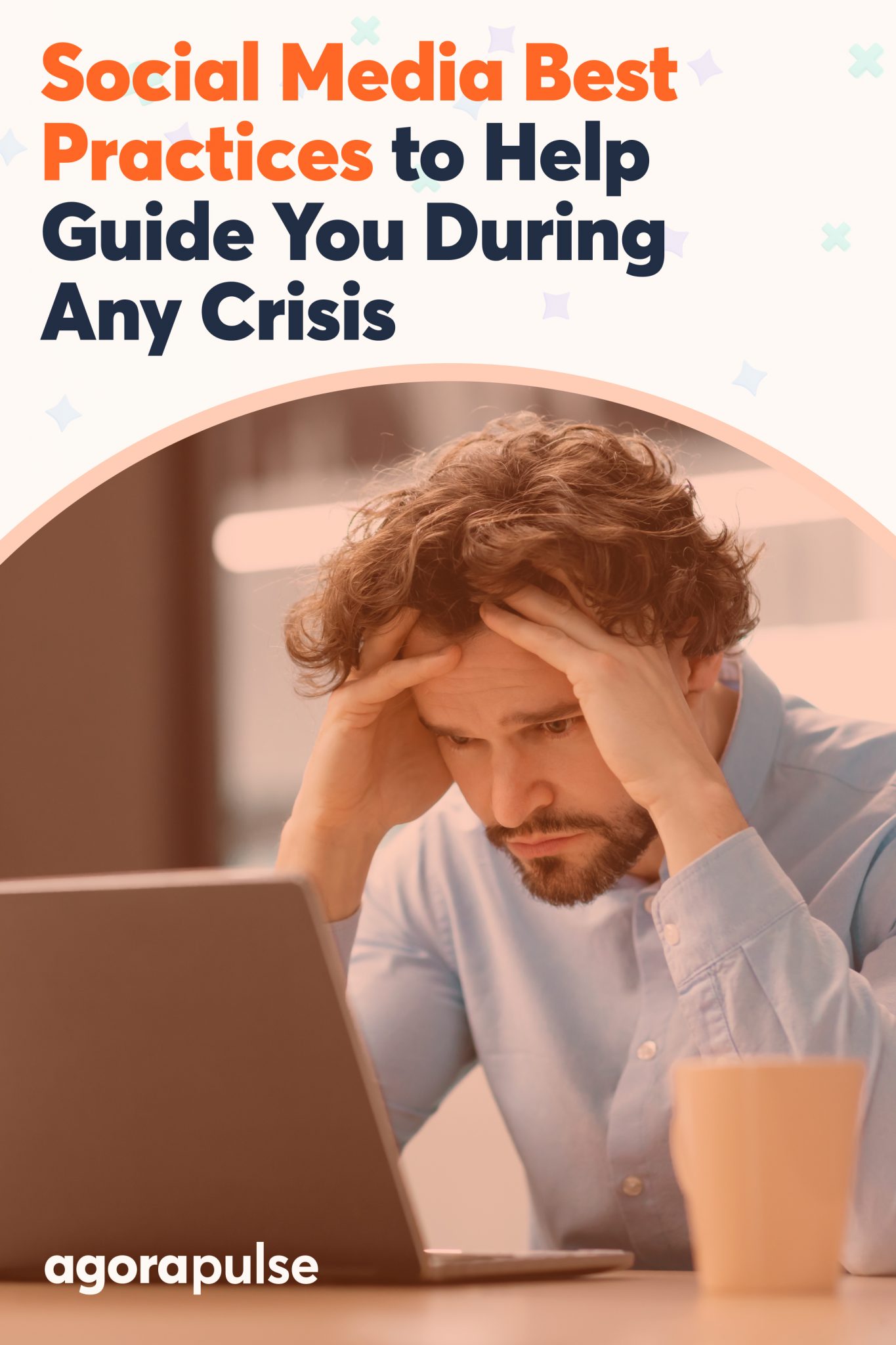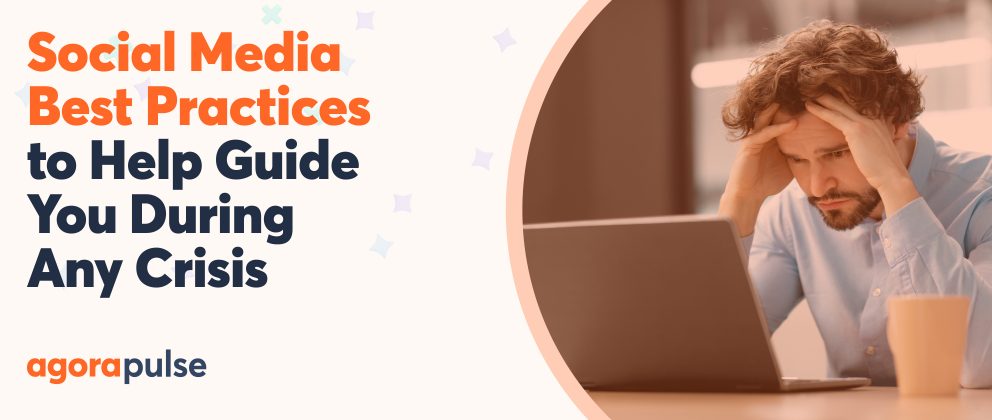You can’t always predict when a crisis is going to hit your business. But you can make sure to have social media best practices in place for when a new crisis pops up.
As a former meteorologist and storm chaser, I’ve been able to see gathering storms and upcoming disasters. But not all tough times can be predicted.
Sometimes, you get sideswiped.
So, you should always have a crisis plan and checklist to use when needed. You don’t want to scramble to determine how to approach the situation.
What Social Media Managers Need to Do First in a Crisis
The No. 1 thing you need to do is pause all scheduled content and take a step back to assess the situation. (Don’t forget to take a couple of deep breaths.)
Understand all sides, and gather all the information possible, so you have a holistic view of the issue at hand. Ask yourself, “Does this impact just our company or is it a national or global concern?”
Initial social media crisis checklist
The following initial crisis checklist should already be part of your crisis plan:
- Check and potentially pause all Facebook, Instagram, Twitter, and LinkedIn Ads. Consider going more into Pinterest, YouTube, and Google instead—where people are actively searching rather than being interrupted with your ad.
- Check and potentially pause any scheduled content.
- Check other social media automation systems like Triberr, Viral Content Bee, Quuu, and other reciprocal sharing systems or RSS Feed aggregators.
- Check your pinned posts on Twitter and Facebook as well as Facebook Group(s) to ensure they’re not tone-deaf.
- Check your website’s copy to make sure it’s not oblivious to the current situation.
- Check your outgoing messages, such as voicemail or even out of office.
- Schedule a team and company meeting to make sure everyone fully understands how to handle the crisis and whether temporary new guidelines need to be in place.
Social Media Best Practices: A Crisis Checklist
Here is a checklist from Facebook Ad expert Amanda Robinson regarding what you need to consider before pausing any ad campaigns.
- Do continue ads as usual if your products and services are still selling normally without interruptions to the supply chain.
- Do re-evaluate your ad copy and make sure it is still relevant in today’s social environment. Leave campaigns alone unless you need to make changes. Note: Editing your Targeting, Creative (e.g., images, text, links, or videos), Optimization, or Billing Event causes your ad to be pulled from inventory and sends it back into Facebook’s review process. Once approved, it is like starting a campaign over from scratch restarting the learning phase.
- Do duplicate campaigns if you need to make edits/changes. This is to preserve the campaign data for how your ads performed originally and then create a new campaign with your changes to compare results.
- Do focus on engagement, video view, and traffic campaigns, so when business and spending resumes, your audience sizes maintain regular volume. You can retarget web visitors up to 180 days (six months) and retarget engagement + video view audiences for up to a year. Reducing spend now means less engagement now, and your audience quality can take a hit in six months to a year.
Social Media Best Practices: Interactions During a Crisis
Next, look at your company’s mission statement and goals. Ask yourself, “How does this problem impact your company’s mission? Can you go on like business as usual? What do you need to tweak?”
Social media best practices: Be intentional in your messaging
Now, put yourself in your customers’ place regarding social media messaging. You need to understand what their thought process is right now, their needs, and their wants.
One of the best things you can do is confront the crisis and then ask your customers, “How can we help you through this?”
Social media best practices: Have a social media strategy during a crisis
You need to be sensitive to the issue. Relate to your audience. Understand that this is a difficult time for your customers and fans, and reassure them you are there for them. Provide useful information they can start implementing immediately to strengthen their company or business.
Remember when curating content during a time of crisis:
- Understand that sometimes it’s best to say nothing.
- Be intentional with the content you post; make sure it is helpful and necessary.
- Provide useful resources that customers can use immediately.
- Prep for extra customer service needs and questions.
- Monitor the situation and breaking news closely to stay aware of the latest developments and how it could impact your business and your customers.
- Avoid getting involved in any political or negative discussions EVER!
- If you’re unsure about how to respond or if you should, ASK!
- Most importantly, BE HUMAN. Treat others like how you would like to be treated.
Social media best practices: Deepen interactions with your audience
People crave interaction and acceptance. During a time where things aren’t normal, maintain some type of normalcy and positivity for your customers and fans.
To understand how they are handling and processing the situation, you can ask them how they are doing and adapting to the situation.
You can also ask, “What is the most important thing you need right now?” Their responses will give you a good idea of the type of resources and content that will benefit them the most.
Strengthening and building your community is a great way to show your support.
If you don’t have a Facebook group or some kind of private group or Slack channel, create one if this is a widespread crisis that will last several weeks to months. In the group, you can share resources and start conversations where members can collaborate to help each other and show support.
Groups are a smart way to show extra support and to prevent potentially “spamming” other people that follow your content on your main social channels that aren’t impacted.
Social media best practices: Communicate with your customers with video
Live video is the best way to directly communicate with your customers and fans, especially during a crisis. If you haven’t done a live video, check out these tips about how to create an Instagram live video or LinkedIn videos. (If you’re awkward in front of the camera, these tips for camera-shy social media managers can help.)
Video responses to social media replies and in company- or customer-wide emails are also a great way to instantly humanize your brand, become more relatable, and connect with your employees and customers—all while getting the appropriate messages you need to get across.
Social media best practices: Focus on the good
A great way to control the conversation and maintain a positive mindset is to highlight any positive outcomes from the situation. Making sure to have positive content is also key to keeping your customers’ thoughts (and yours) positive.
Any easy way to do this is to ask your customers and fans, “What positive thing has happened to you personally or professionally recently?” You’ll likely be amazed by the outpouring of responses that come in.
Along with connecting with your customers and fans, one of the most critical components to successfully responding to a time of crisis is making your PR and social media teams and messages align.
How PR and Your Social Media Team Need to Work Together
Digital strategist Stephanie Liu shares her insight on the best ways for your PR and social media teams to work together:
“It’s important for PR and social media teams to cooperate on a unified message that will be broadcast across all channels. It’s not about speed, it’s about strategy. This is an opportunity for both teams to discuss what works and what doesn’t work on channels to eliminate blind spots.
“This isn’t a time to play email whack-a-mole either. Schedule a conference call to lay out the details and next steps. Taking a few extra beats now to get your strategy right can help prevent having to work on damage control later because your initial messaging didn’t have the right tone or all the information it needed to convey.
“Next, have processes in place to Manage Your Online Presence.
“When an event like the novel coronavirus impacts all industries, there’s more that your Social Media team can do in addition to keeping customers informed with posts. Take the time to update your hours of operation across all social media profiles and online listings that appear in search results, such as Google My Business, Yelp, and so on.
“If the way that you conduct business has or will change, post about that as well. Be transparent and communicative so that your audience is as well informed as you can make them.
“If you don’t already have a Crisis Playbook, create a Google Doc now and start documenting everything that you’re doing through the current issue, so each time your team has to navigate trouble, there’s less confusion and delay.
“For some businesses and thought leaders, the next step is an interesting one: Winning the Pitch.
“If you or your client is the subject matter expert in a particular industry, the PR team can look for opportunities to pitch the media and provide expertise either written or via video interview. The social media team can help support the pitch by providing a list of curated content that can be used in the media overview, such as past instances of interviews.
“Even better, create a content library organized by topic to make finding and repurposing content even faster. Say, for example, the CEO for one of your client brands is an expert on managing a remote workforce and has blog posts, guest columns and major media outlet interviews they’ve done on the topic in the past. A savvy PR team will have those at their fingertips to reference when reaching out to journalists and media outlets.
“If you aren’t already, jump into Help A Reporter Out (HARO) where you can search for active media stories, as well as set up alerts for new requests that might be of interest.
“Finally, with PR and Social Media working overtime during a PR crisis, we always recommend updating your email signature to link to the latest updates. This will give recipients an opportunity to stay updated while waiting for your timely response.
“This applies to both internal and external issues. When it’s an external issue, you can have blog content or videos there to simply help your audience and customers with whatever is going on. If it’s an internal issue, you may have a press release or landing page with updated information and resources.
“As with any issue, pre-planning can help tremendously, but no amount of pre-planning can anticipate every nuance of any crisis. So give yourself time to consider what has happened or is happening, how it will impact your business and, most importantly, what your customers and audience is most concerned about. Then set out to be the best possible communicators you can be.”
In Conclusion
Be proactive in your approach, so your customers know where your company stands, what resources you can provide, and if there are any changes to hours of operation or processes.
Remember no matter the situation, be compassionate, understanding, and relatable as your customers’ needs change. You need to maintain a fluid strategy that can easily be pivoted due to changing circumstances.
Lastly, be the kind of company you would want them to be if you were a customer.
* * *
Put your social media best practices plan into action! Check out our free trial of Agorapulse to help you schedule, track, and measure all your social media efforts.








